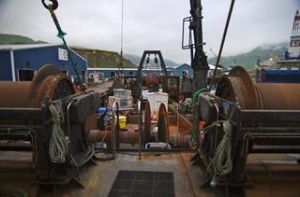
Fishing is off-limits in the Arctic, but last summer, a pair of commercial trawlers traveled north to the Chukchi Sea. They were on a scientific mission, to conduct the first-ever comprehensive study of the Chukchi’s ecosystem.
Franz Mueter is the lead scientist on the study, and he’s attending the Alaska Marine Science Symposium in Anchorage this week to present some of the results. He says his team came back with heaps of samples.
“We found about 66 fish species and over 350 invertebrate species in the bottom trawl survey.”
Mueter is a University of Alaska Fairbanks fisheries professor. He’s leading the trawl study in American Arctic waters, and his goal is to gather a baseline dataset for marine life in the area before climate change and oil and gas development alter the ecosystem.
While some of parts of the Chukchi sea floor have been studied before — mostly around oil and gas lease sites — Mueter’s survey is much more comprehensive. The two vessels covered a 30-mile grid, weaving back and forth to capture sea life living on the surface, in the middle of the water column, and on the ocean bottom.
They found plenty of flatfish and Arctic cod, plus a large colony of snow crab in the Chukchi, but not all of the creatures they pulled up were so easily recognizable.
“NOAA had never done a survey in that area, or at least not in many years. And they didn’t have species codes for a lot of the species in their database,” Mueter says.
But even though some of the animals haven’t turned up for a long time, Mueter doubts they’re new species:
“I suspect that most of them have probably been seen before.”
Mueter’s team is planning another field trip to the Chukchi this summer, to re-trawl the surface and midwater with a smaller net, in hopes of collecting smaller species they might have missed in 2012. In the meantime, they’re sharing their big-picture data with other scientists working on more focused projects.
Mueter himself is interested in taking a closer look at Arctic cod as an indicator of climate change. The trawl survey showed that Arctic cod fills a role in the Chukchi like pollock does in the Bering Sea. It’s a plentiful food source for seabirds and mammals in the area. And as the climate changes, it’ll be on the move.
“We know it’s responsive to temperature variability,” Mueter says. “So the southern extent of the species shifts a lot with temperature. As the temperature cools, it expands further south and as the temperature warms up, it retreats into the colder portions of the Arctic.”
While the Arctic cod is a good indicator of what the climate’s doing, the fact that the climate is changing is also a problem for these researchers. The baseline that they’re trying to establish might be more of a moving target.
Still, the data will have practical uses in the short term. Mueter’s team thinks the government can use it to determine the environmental impacts of offshore oil leases.
It’s also going to come in handy for resource managers, who are trying to figure out whether it’s safe to open parts of the Arctic to commercial fisheries — and not just fishing boats moonlighting as research vessels.
Related stories:




